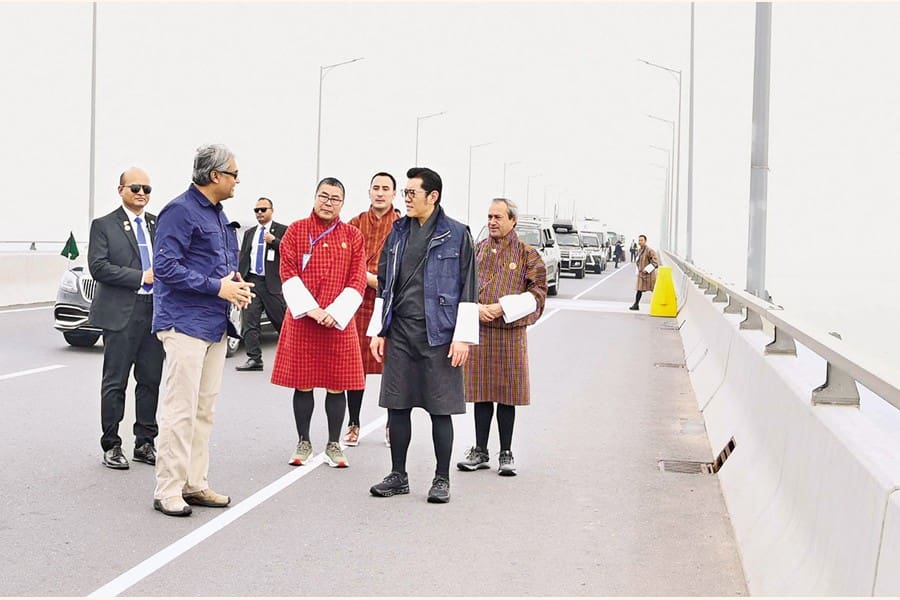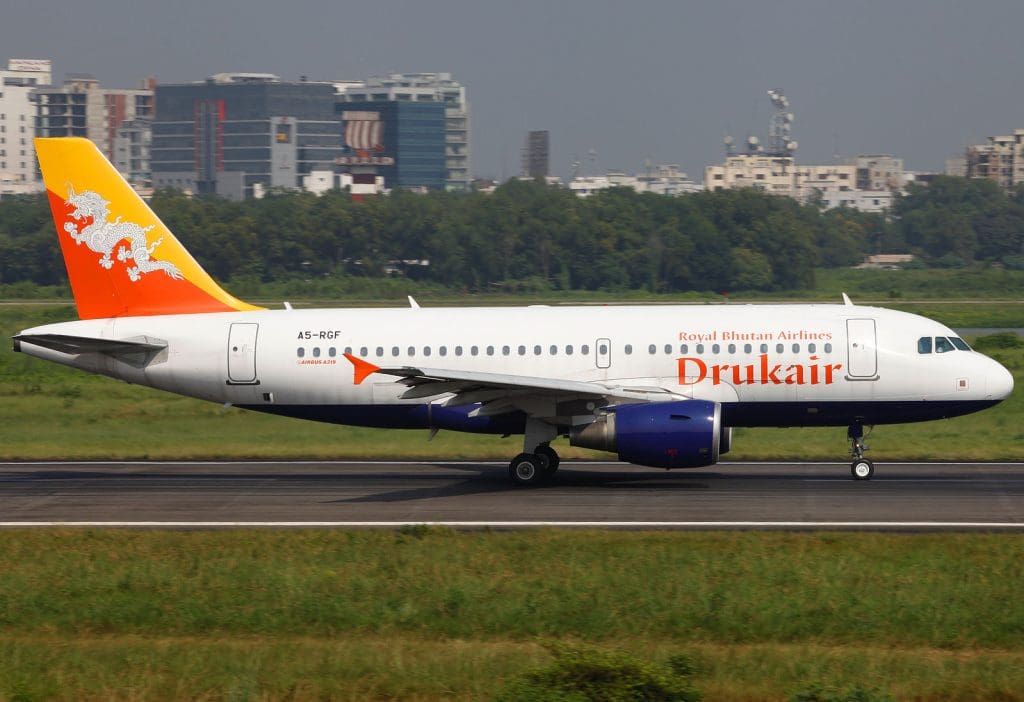King Jigme Khesar Namgyel Wangchuck of Bhutan visited Bangladesh to attend the celebration of the Independence and National Day of Bangladesh on March 26 as a special guest. Alongside the King, there was Jetsun Pema Wangchuck, the Queen of Bhutan. Bhutan agreed to invest in an economic zone in Kurigram, Bangladesh, alongside other promises by the two sides.
The King of Bhutan was invited by President Mohammed Shahabuddin, for an official state visit from March 25 to 28. The President Mohammed Shahabuddin and First Lady Rebecca Sultana greeted the royal couple cordially at the Hazrat Shahjalal International Airport. A military team provided a guard of honour and the red carpet was rolled out for the visit. The Bhutanese king’s visit to Bangladesh is evidence of the warm and friendly relations that happily exist between the two nations.
This visit took place at a time when Bangladesh was celebrating its 53rd Victory from Pakistani rule and showcasing its economic and development growth as one of the emerging Nations. Bhutan has a special place in many of Bangladesh’s hearts as it was one of the first nations to recognize Bangladesh in 1971. On December 6, 1971, early in the morning, King of Bhutan Jigme Dorji Wangchuck sent a telegram to Syed Nazrul Islam, the Acting President of the Provisional Government of Bangladesh, recognizing the new nation as the Bangladesh Liberation War was coming to an end and victory over West Pakistani forces was imminent.
On behalf of my Government and myself, I would like to convey to Your Excellency and the Government of Bangladesh that we have great pleasure in recognizing Bangladesh as a sovereign independent country. We are confident that the great and heroic struggle
of the people of Bangladesh to achieve freedom from foreign domination will be crowned with success in the close future.

King Jigme Dorji Wangchuck
On his telegram to Syed Nazrul Islam
The Bhutanese government initiated diplomatic relations with Bangladesh immediately after independence, and on April 12, 1973, formal diplomatic relations were formally established. As a gesture of profound gratitude and to cherish Bhutan’s contribution to the Liberation War, His Majesty Jigme Dorji Wangchuck, the Third King of Bhutan, was posthumously awarded the Bangladesh Liberation War Honour in 2012.
The King’s Visit
During his visit, The King of Bhutan paid tribute to Bangabandhu Sheikh Mujibur Rahman, the Father of the Nation, by visiting the Bangabandhu Memorial Museum upon their arrival in Dhaka. The Prime Minister of Bangladesh expressed gratitude for the crucial assistance provided by the people of Bhutan and King Jigme Dorji Wangchuck, the Third King of Bhutan, during Bangladesh’s War of Independence.
In the presence of the Bangladeshi Prime Minister Sheikh Hasina and the King, a series of Memoranda of Understanding and Agreements were signed to promote trade, cooperation, and cultural exchanges between Bhutan and Bangladesh. King Jigme conveyed his sincere gratitude for the kind welcome and gracious hospitality shown to Him and the members of His delegation. Against such a backdrop, the State Visit by the King of Bhutan to Bangladesh showcases the strong and long-standing relationship between the two nations.
Increased Avenues for Bilateral Cooperations
In the course of the formal meeting, both PM Sheikh Hasina and the Bhutanese King conveyed their satisfaction with the current status of relations between Bhutan and Bangladesh, which is particularly unique given their shared history, proximity, and common aspirations for prosperity and development.
Three new memorandums of understanding (MoUs) have been signed by Bangladesh and Bhutan to strengthen their bilateral cooperation. The two amicable South Asian nations also decided to strengthen their cooperation in the fields of agriculture, trade and commerce, connectivity, power, education, culture, and interpersonal interactions, among other things.

King Jigme Dorji Wangchuck also paid a visit to the Padma Bridge, a remarkable piece of infrastructure built entirely with funds provided by the Bangladeshi government. This outstanding infrastructure project is evidence of Bangladesh’s dedication to promoting economic growth and increasing connectivity.
MoU Signed between the parties
Establishment of Burn & Plastic Surgery Unit in Thimpu
MoU between Bhutan and Bangladesh for Cooperation on establishment of a Burn and Plastic Surgery Unit in Thimphu and Health Cooperation.
Establishing Bhutanese Special Economic Zone in Kurigram
MoU between Bhutan and Bangladesh for Cooperation on establishing Bhutanese Special Economic Zone in Kurigram, Bangladesh by Bhutan
Consumer Rights Protection
MoU between Competition and Consumer Affairs Authority of Bhutan and the Directorate of National Consumers Right Protection of Bangladesh
The following Memoranda of Understanding (MoUs) were signed: one between the Directorate of National Consumers Right Protection of Bangladesh and the Competition and Consumer Affairs Authority of Bhutan; another between Bhutan and Bangladesh for cooperation on the establishment of a Bhutanese Special Economic Zone in Kurigram, Bangladesh; and a third between Bangladesh and Bhutan for cooperations on the establishment of a Burn and Plastic Surgery Unit in Thimphu and Health Cooperation.
Bhutan-Bangladesh Trade
Special Economic Zone in Kurigram
190 kilometers from Gelephu, Bhutan’s southernmost city
Standard Operating Procedure
For smooth inland waterway use
First Preferential Trade Agreement
For both countries
Power and Energy Cooperation
Subregional level
Bhutan expressed gratitude to Bangladesh for providing the “Special Economic Zone” in Kurigram, which is located 190 kilometers from Gelephu, Bhutan’s southernmost city, in the northern portion of the country. The economic zone will open up new possibilities for bilateral investment and trade between the two nations as well as for bringing about greater prosperity throughout South

The growing trend in trade between Bangladesh and Bhutan in recent years was acknowledged with satisfaction by both parties. They expressed their happiness with the recent trade-facilitating measures between the two nations, including the Standard Operating Procedure (SOP) for smooth inland waterway use and the Preferential Trade Agreement (PTA), which is the first of its kind for both nations. An important area of cooperation between Bangladesh and Bhutan is the power and energy sector. Regarding this, Bhutan, Bangladesh, and India’s subregional cooperation in the energy sector needs to be strengthened, as both sides emphasized.
A New Horizon for Regional Connectivity
Bhutan and Bangladesh joined the SAARC as founding members in 1985. In 1986, Druk Air, the national airline of Bhutan, began operating scheduled flights between Paro and Dhaka. This was the second international route of Drukair. The 659 kilometers of road that separated the two capitals, Thimphu and Dhaka, were connected in a way that was both functional and symbolic. However, Drukair flights to Dhaka were halted for some time before resuming in 1998. Under a new agreement with Biman (Bangladesh’s national airline) Drukair resumed operations to Dhaka. The agreement allowed Drukair to fly to Dhaka where passengers wishing to continue were then supposed to be transferred on to a Biman flight for Bangkok. Even though Drukair can fly to Bangkok directly, Biman had significant contribution in the development of Drukair’s Bangkok route.

More connectivity with the ports of Chittagong and Mongla will be possible with the signing of a memorandum of understanding (MoU) between Bangladesh and Bhutan on the use of inland waterways for the transit of cargo and bilateral trade. Nevertheless, the signing of the Agreement on the Movement of Traffic-in-Transit and its Protocol in March 2023 by Bangladesh and Bhutan, which will open up new avenues for bilateral trade and connectivity, was welcomed by both countries.
Druk Air
Partnership in Bangkok Route between Druk and Biman
Connectivity with Chittagong and Mongla Port
Use of inland waterways for transit
Hydropower
As part of strategic development partnership
Both Bangladesh and Bhutan agreed that mutual peace and prosperity in the region depend greatly on regional cooperation. In addition to being fantastic for bilateral trade, the Agreement and its Protocol will serve as a foundation for a connected South Asia. The importance of regional and sub-regional connectivity in promoting trade and commerce as well as economic integration was acknowledged by both parties. They expressed satisfaction in noting that the two sides’ joint efforts to improve connectivity via roads, rails, and waterways will boost economic growth and regional integration in South Asia in addition to strengthening bilateral ties.
According to the Joint statement shared by Bangladesh and Bhutan after the visit, it expressed that to guarantee better regional cooperation, the two nations need to collaborate in regional organizations like SAARC and BIMSTEC. The two nations have pledged to work together on transportation, free trade, and hydropower as part of a strategic development partnership in recent years.
Bangladesh participates in and collaborates with a wide range of regional organizations and mechanisms, including BIMSTEC, SAARC, the Colombo Plan, and the United Nations Economic and Social Commission for Asia and the Pacific. It has made great strides, and under these platforms, several initiatives and projects in important areas of cooperation are in the works. Asia. The significance of enhancing subregional cooperation between Bangladesh, India, and Bhutan in the energy sector was emphasized by both parties. If these initiatives can be materialized, they can help South Asia to transform into an economic and regional connectivity hub.
It is particularly important to note that, Bangladesh has recently finalized the import of 40MW energy from Nepal through India and Bangladesh will invest in the Sunkoshi-3 hydro power project in Nepal. Alongside Nepal, Bangladesh is seeing Bhutan as a potential energy partner in the future.
“People to People” connections are getting Prioritised
The fact that Bangladesh and Bhutan have had excellent people-to-people contact for many years pleased both parties reaffirmed that they need to connect to further enhance the people-to-people exchange between Bangladesh and Bhutan by connecting the Himalayas in Bhutan with the longest sea beach in Cox’s Bazar, Bangladesh. Bhutan and Bangladesh renewed their agreement on cultural cooperation is a milestone achievement in their bilateral relationship.
Tourism
by connecting the Himalayas in Bhutan with the longest sea beach in Cox’s Bazar
Medical Education
MBBS capacity for Bhutanese students to increase from 25 to 30 as proposed by Bangladesh
Both parties expressed satisfaction with the steady increase in the number of Bhutanese students being accepted each year for admission to Bangladesh’s public medical colleges’ MBBS programs. Bhutanese former Prime Minister Lotay Tshering graduated from Mymensingh Medical College at the University of Dhaka, Bangladesh, and received a degree of MBBS in 2001.To strengthen the already strong cooperative momentum, Bangladesh proposed raising the yearly MBBS capacity for Bhutanese students from 22 (twenty-two) to 30 (thirty). These aspects of bilateral relations need to be prioritized more by both Governments.
Geographically adjacent nations, the two have long shared a friendship built on their shared goals of world peace, respect, shared prosperity, and closer integration. Both nations have progressed socioeconomically in a comparable manner and are expected to graduate from the Least Developed Countries within the next ten years. Even though the two nations are proud of their shared history of cooperation and advancement on many fronts, their future is equally appealing and their bilateral ties are even more promising because of the opportunities that remain and the unrealized potential. To “consolidate the already excellent” relations for the benefit of their people, the two must remain forward-thinking and maintain their momentum.
About the Author

Saume Saptaparna Nath is an MSS student at the Graduate school of International Public Policy, Osaka University and a MEXT Scholar. She has worked as a research Associate at The KRF Center for Bangladesh and Global Affairs (CBGA). She has pursued her graduation and Post-graduation from the Department of International Relations, University of Dhaka.
1 comment
[…] and Mongla port for goods shipment from mainland India to the North-eastern region. Apart from that Bangladesh and Bhutan have a transit agreement since 2023 to use Bangladesh’s land, sea, and air routes for […]